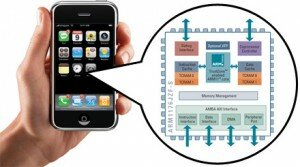Recently I was working on the power supply for our upcoming SnapperDV board. I needed a small efficient power supply to generate 1.3, 1.8 and 3.3volts for TIs TMS320DM355 which is the CPU on SnapperDV. On our Snapper270 design a TPS65021 is used which is a tripple DC/DC converter with two LDOs. Something similar would be ideal. After looking at all the options, strangely the same power supply chip seemed most suitable. Current limit looked good, the power fail detection comparators can be used instead for voltage sequencing, VRTC can be used as a system monitor voltage, the nINT output can be used as a voltage supervisor, The LDO can be used to power the CPUs PLL. It actually works out to be a very good fit - even though it is recommended for a PXA270 series CPU and it is not being used 'as intended'. Taken into account that we have these in stock given they are used on our SN270 product and it looks to be a very good proposition indeed.

Apple an ARM Licensee?Posted in Industry News on August 04, 2008 by Administrator
[Talking about DEC who implemented StrongARM based on an architectural license] And who was the engineer that had led the Digital Equipment team that developed StrongARM under an architectural license? It was Dan Dobberpuhl, subsequently CEO of Palo Alto Semiconductor Inc. With the recent acquisition of P.A. Semi by Apple, Dobberpuhl has become an Apple employee. And perhaps now, with ARM's disclosure, we are beginning to see why Apple was interested in Dobberpuhl and his capable design team.[The Apple rumour mill is running hard also]. And this is supposedly the motivation: The Apple iPhone is thought to have as many as five ARM processor cores inside it, but those processor cores are contained in multiple chips from several different chip vendors. Wouldn't that be perfect for rationalizing into a multicore ARM architecture, if Apple chose to go down that route?Certainly there is merit in this - it is what Nokia have done with their communicator, which, believe it or not, used to have a 386 CPU and an ARM. The 386 was for keeping your hand warm. Most Bluetooth and WiFi devices include an ARM core. The iPhone is ARM11-based, not the latest thing but still pretty nifty. Sadly, if Apple do produce an amazing new microarchitecture, it's unlikely we will see it in anything other than an Apple product. On the plus side, as StrongARM vanished, the prize for building a high performance ARM chip, well out in front of the industry, has not been awarded for years. The right machine for the time.Posted in Uncategorized on August 02, 2008 by Administrator
|






